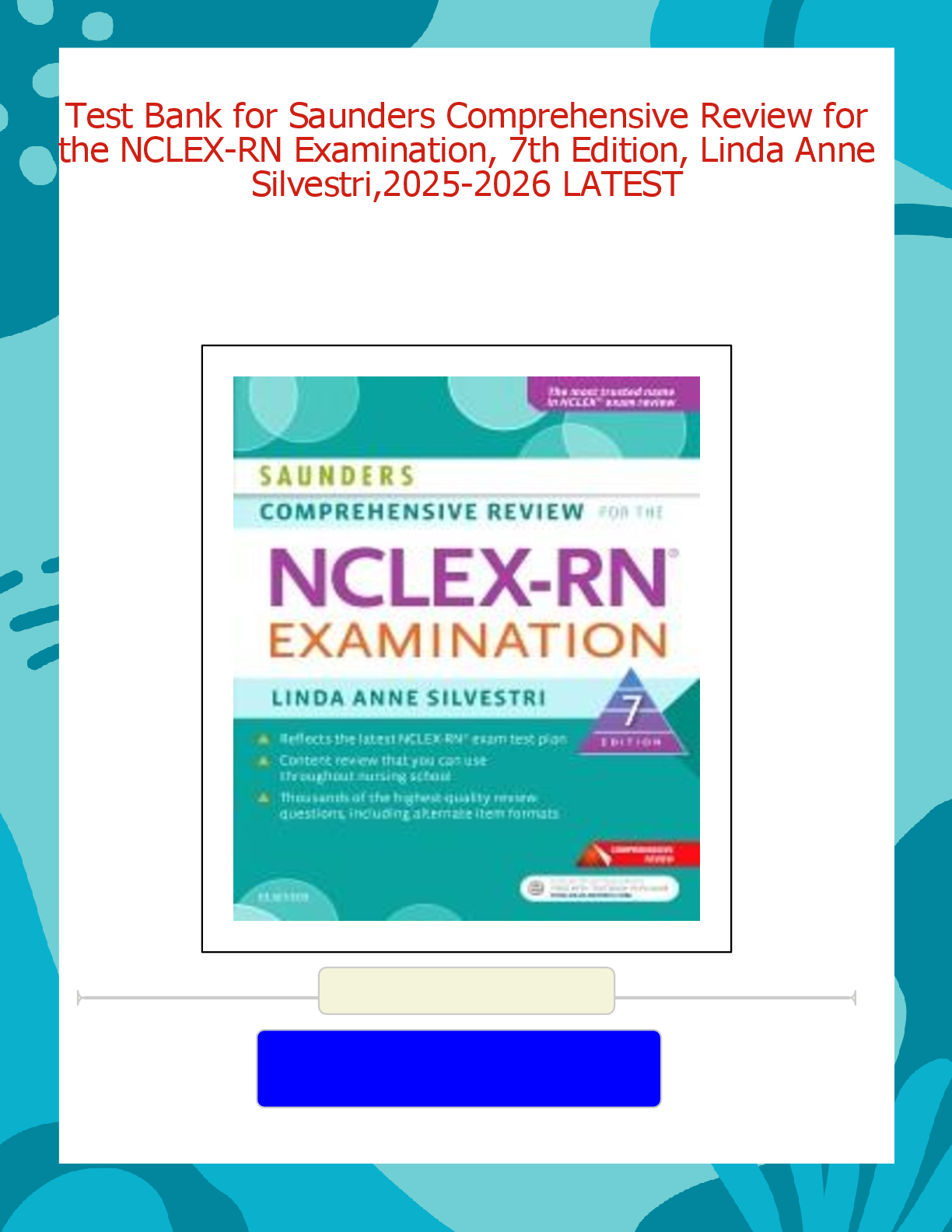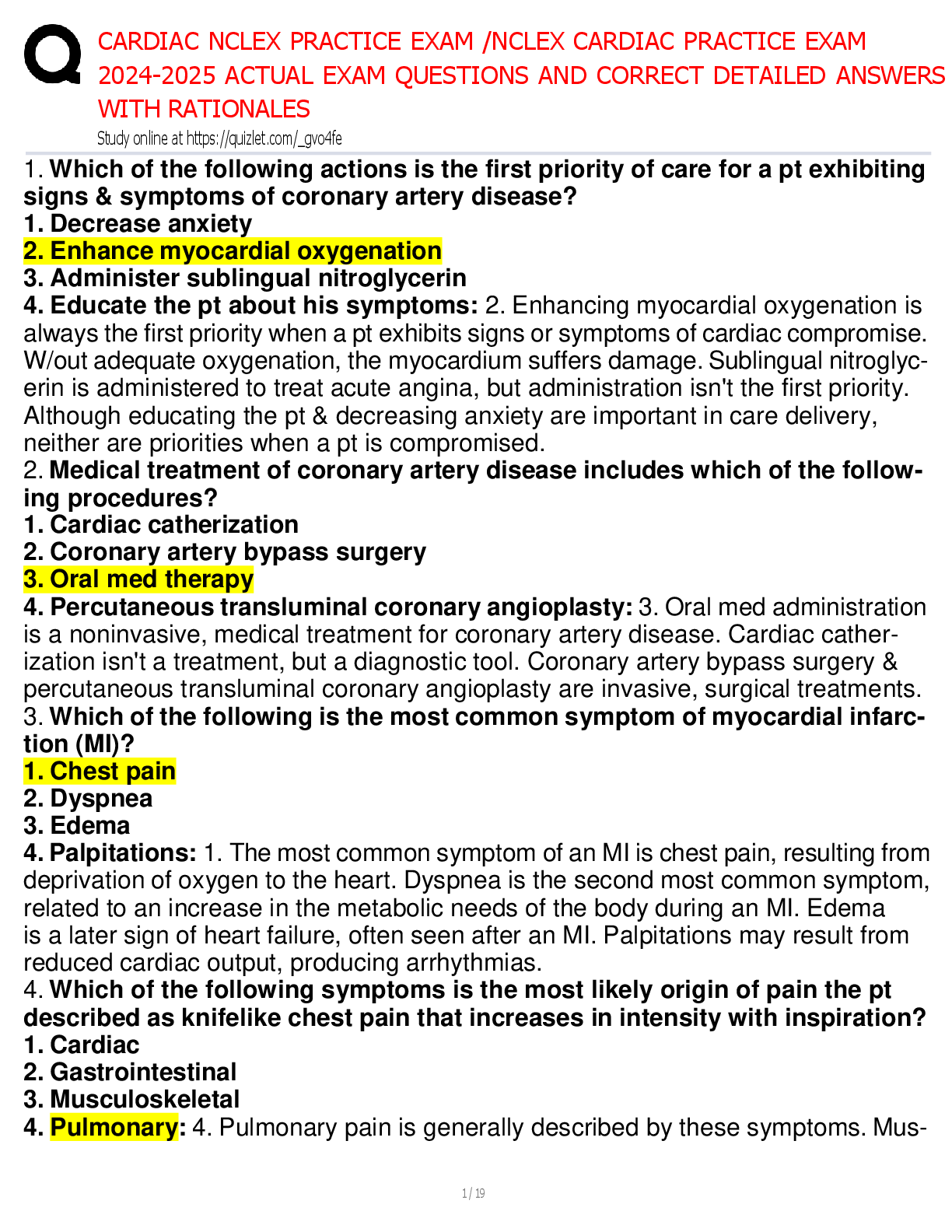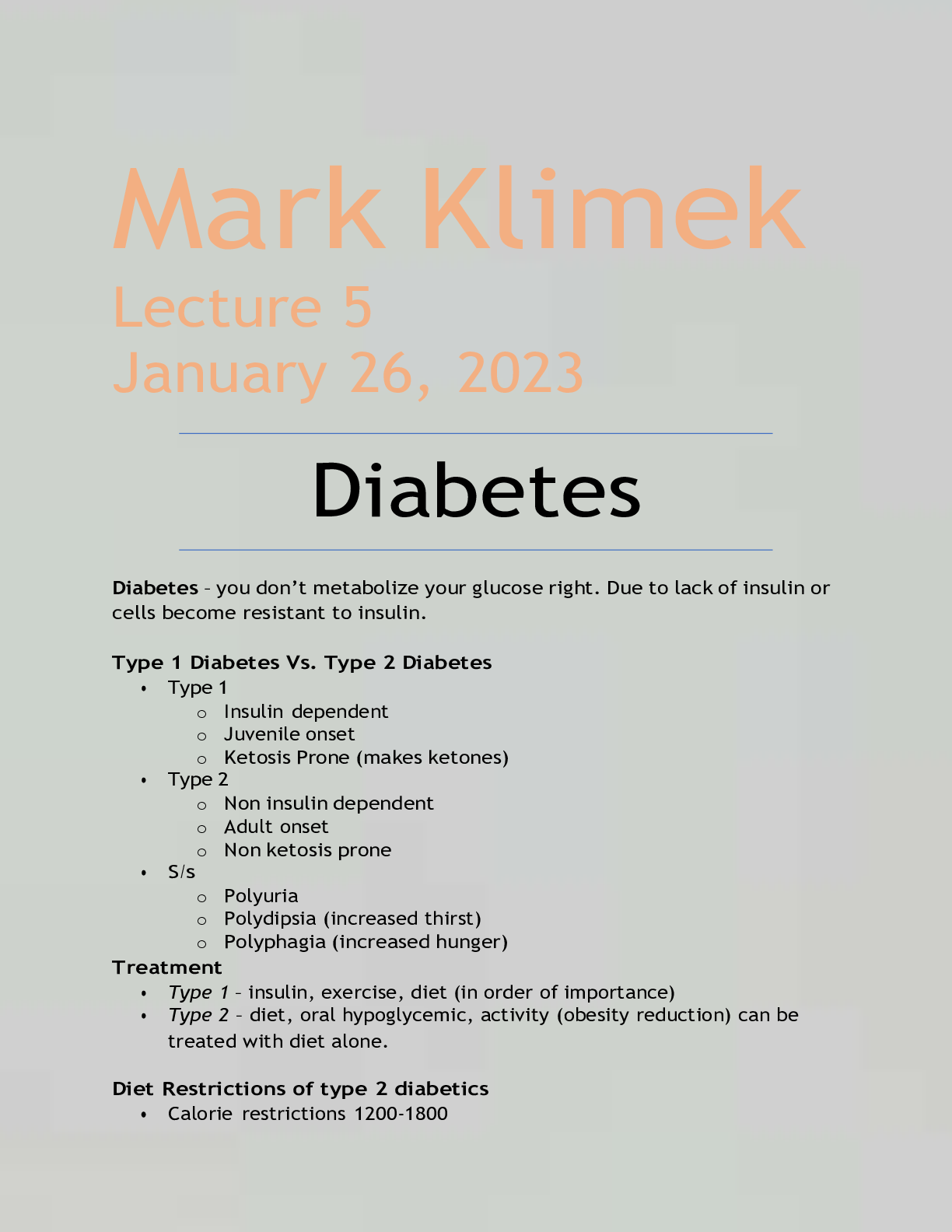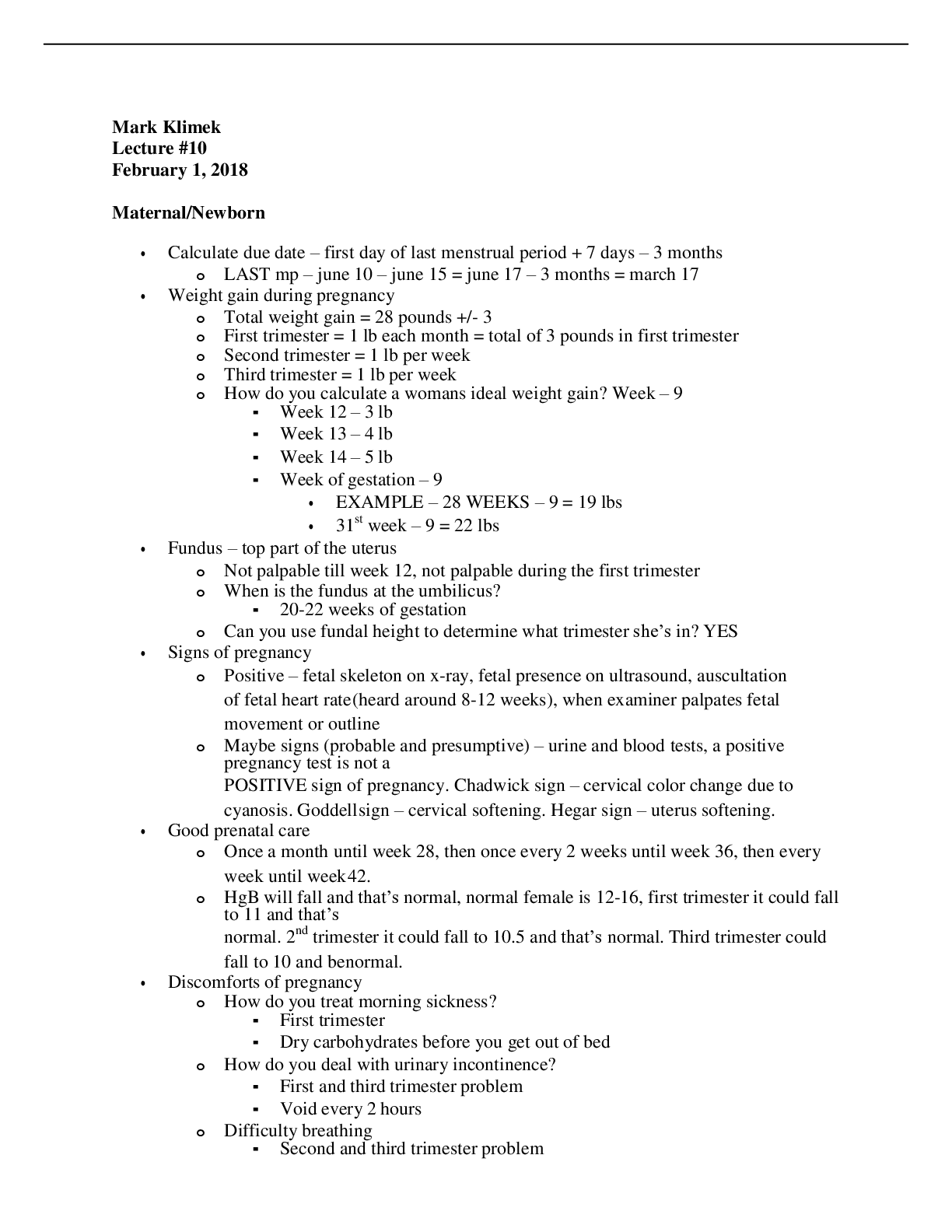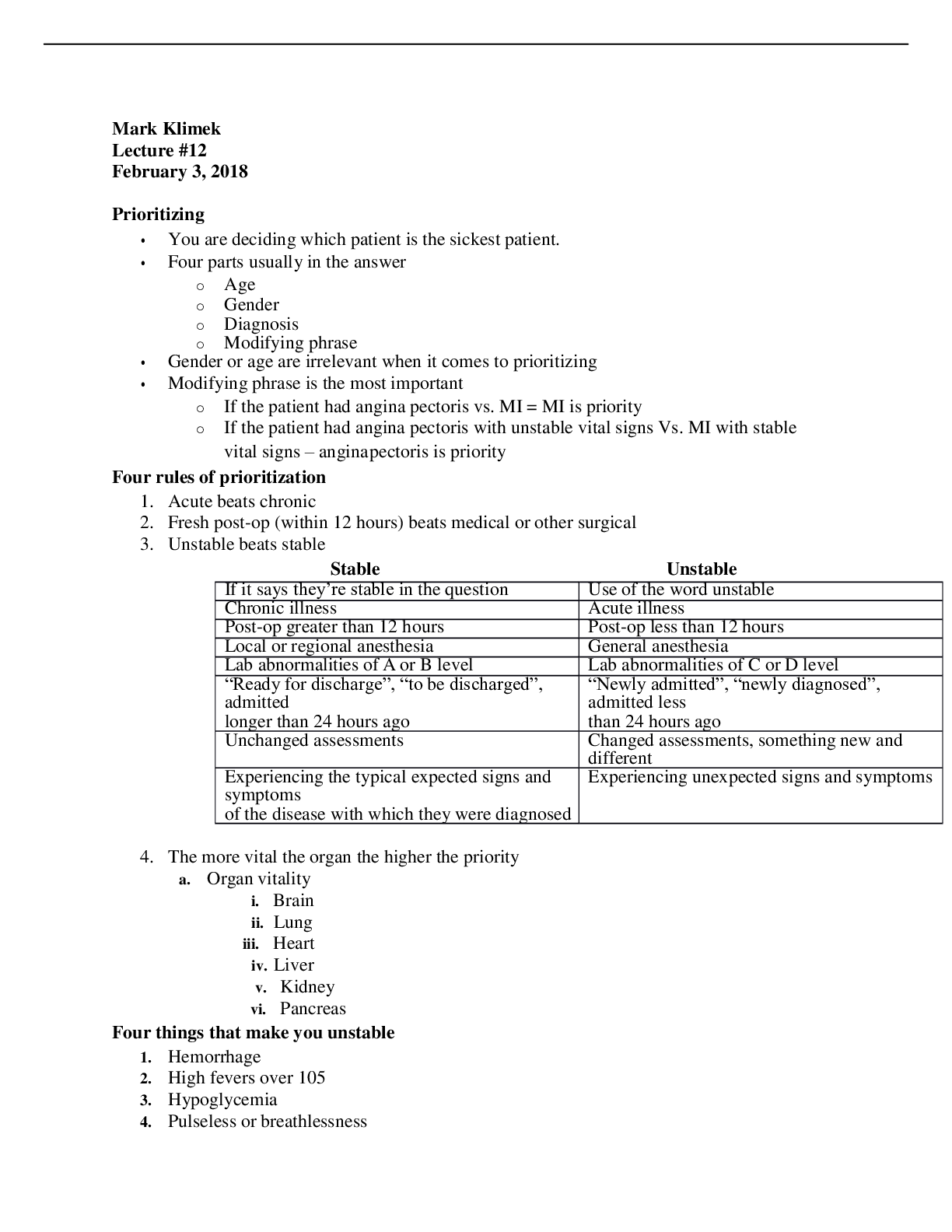Mark Klimek NCLEX > NCLEX > NCLEX REVIEW,Mark Klimek Lecture 3 Cardiac Medication, Calcium Channel Blockers, Cardiac Arrhythmia (All)
NCLEX REVIEW,Mark Klimek Lecture 3 Cardiac Medication, Calcium Channel Blockers, Cardiac Arrhythmias, Chest Tube, Congenital Heart Defects, Infectious Disease, PPE Mark Klimek Lecture 3 Cardiac Medication, Calcium Channel Blockers, Cardiac Arrhythmias, Chest Tube, Congenital Heart Defects, Infectious Disease, PPE Next Gen NCLEX Review,2025-2026.
Document Content and Description Below
Lecture 3 Cardiac Medication, Calcium Channel Blockers, Cardiac Arrhythmias, Chest Tube, Congenital Heart Defects, Infectious Disease, PPE Calcium Channel Blockers CCBs (Calcium channel block... ers) are like Valium for the heart - They relax and slows down the heart - In other words, CCBs have negative inotropic, chronotropic, dromotropic effects on the heart (+) Inotropy, Chronotropy, Dromotropy Positive inotropy Increase cardiac contractile force → Ventricles empty more completely → Cardiac output improved Positive chronotropy Increase rate of impulse formation at SA node → Accelerate heart rate Positive dromotropy Increase speed that impulses from SA node travel to AV node (increase conduction velocity) (–) Inotropy, Chronotropy, Dromotropy Negative inotropy Weaken/decrease the force of myocardial contraction Negative chronotropy Decrease rate of impulse formation at the SA node → decelerate heart rate Negative dromotropy Decrease speed that impulses from SA node travel to AV node (decrease conduction velocity) When do you want to relax and slows down the heart? … To treat “A, AA, AAA” - Antihypertensive - AntiAnginal drugs (decreasing oxygen demand) - AntiAtrialArrhythmia Side Effects Headache and hypotension Name: ends in “dipine” … Not “pine” - Also, verapamil, Cardizem (diltiazem) - Cardizem (diltiazem) is given continuous IV drip What are the parameters to assess before putting a pt on CCBs? - Assess for BP - Hold if SBP <100 Latest NCLEX Reviews: https://linktr.ee/NclexRN Downloaded by Morris Muthii (muthiimorris68@gmail.com) lOMoARcPSD|40307388 Cardiac arrhythmias - Knowing how to interpret rhythm. - Must know the following 4 cardiac rhythms by sight Normal Sinus Rhythm - There is a P wave, followed by a QRS, followed be a T wave for every complex - Peaks of the P wave is equally distant to the QRS, and fall within 5 small boxes Ventricular Fibrillation - No pattern Ventricular Tachycardia - Sharp peaks with a pattern Asystole - A flat line Extras: Latest NCLEX Reviews: https://linktr.ee/NclexRN Downloaded by Morris Muthii (muthiimorris68@gmail.com) lOMoARcPSD|40307388 If the question mentions - QRS depolarization = Ventricular - P wave = Atrial There are 3 levels of nursing knowledge 1. Stuff you need to know 2. Stuff that is nice to know 3. Stuff that is nuts to know The 6 rhythms most tested on the NCLEX 1. A lack of QRS complexes is asystole—a flat line 2. P waves (atrial) in the form of saw tooth wave = atrial flutter 3. Chaotic P wave patterns = atrial fibrillation (a-fib) (Chaotic: word used to describe fibrillation) 4. Chaotic QRS complexes = ventricular fibrillation (v-fib) 5. Bizarre QRS complexes = ventricular tachycardia (v-tach) (Bizarre: word used to describe tachycardia) 6. Periodic wide bizarre QRS complexes = PVCs (Salvos of PVCs = A short runs of v tach) PVCs (premature ventricular contractions) are usually low priority • However, elevate them to moderate priority if under the following 3 circumstances - There are 6 or more PVCs in a minute - More than 6 PVCs in a row - R on T phenomenon (a PVC falls on a T wave) • PVCs after an MI is common and is a low priority Lethal arrhythmias are high priority and will kill a patient in 8 minutes or less. They are: • Asystole and V-fib (ventricular fibrillation) • Both rhythms produce low or no cardiac output (CO), without which there is inadequate or no brain perfusion. This may lead to confusion and death Potentially Lethal Cardiac Arrhythmia V-tach (ventricular tachycardia) is a potentially lethal cardiac rhythm, but it has a CO How would a patient with or without CO presents? - CO is absent = there is no pulse - CO is present = there is a pulse Latest NCLEX Reviews: https://linktr.ee/NclexRN Downloaded by Morris Muthii (muthiimorris68@gmail.com) lOMoARcPSD|40307388 Treatment of PVCs and V-tach - Ventricular = Lidocaine - Both are ventricular rhythms - Treat with Lidocaine - Amiodarone is eventually the NCLEX board will want as answer Supraventricular arrhythmias are Atrial arrhythmias (supra = above) Treatments are “ABCDs” - Adenocard (Adenosine) … Fast IV push (push in less than 8 seconds and 20 mL NS flush right after) … These pts will go into asystole for about 30 seconds and out of it - Beta-blockers (end in -olol) - CCBs - Digitalis (digoxin), Lanoxin (another digitalis analog) Beta-blockers have negative inotropic, chronotropic, dromotropic effects on the heart. They treat “A, AA, AAA” - Antihypertensive - AntiAnginal drugs (decreasing oxygen demand) - AntiAtrialArythmia - Side Effects = Headache and hypotension Treatment of V-fib and Asystole - Defib for V-fib (Defib = defibrillate = Shock em!) - Epinephrine and Atropine for Asystole Tx: Atrial arrhythmias - Adena - Beta - Calcium - Dig Tx: Ventricular arrhythmias - Lidocaine - Amiodarone Latest NCLEX Reviews: https://linktr.ee/NclexRN Downloaded by Morris Muthii (muthiimorris68@gmail.com) lOMoARcPSD|40307388 Chest Tubes Purpose: to reestablish negative pressure in the pleural space … Negative pressure in the pleural space makes thing stick so that the lung expands when the chest wall expands - Pleural space is the space between the lung (visceral pleura) and the chest wall (parietal pleura) - In a pneumothorax, chest tube removes air - In a hemothorax, chest tube removes blood - In a hemopneumothorax, chest tube removes air and blood Question A chest tube is placed in a pt for a hemothorax (blood). What would you (the LPN) report to the nurse? Or, what would you (the RN) report physician? a. Chest tube is not bubbling b. Chest tube drains 800 mL in the first 10 hours c. Chest tube is not draining d. Chest tube is intermittently bubbling What is the chest tube not supposed to do? The chest tube is supposed to drain instead of bubbling Therefore answer (c) is the right answer. Question A chest tube is placed in a pt for a pneumothorax (air). What would you (the LPN) report to the nurse? Or, what would you (the RN) report physician? a. Chest tube is not bubbling b. Chest tube drains 800 mL in the first 10 hours c. Chest tube is not draining d. Chest tube is intermittently bubbling [Show More]
Last updated: 4 months ago
Preview 5 out of 30 pages

Loading document previews ...
Buy this document to get the full access instantly
Instant Download Access after purchase
Buy NowInstant download
We Accept:

Reviews( 0 )
$14.50
Can't find what you want? Try our AI powered Search
Document information
Connected school, study & course
About the document
Uploaded On
Mar 17, 2025
Number of pages
30
Written in
Additional information
This document has been written for:
Uploaded
Mar 17, 2025
Downloads
0
Views
32


